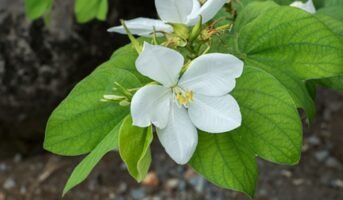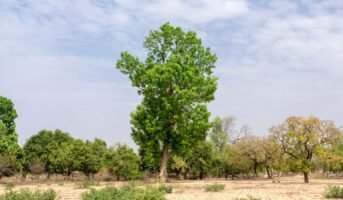The common pear, scientifically known as Pyrus communis, is a species of pear that is indigenous to western Asia and central and eastern Europe. Pyrus is an ancient Latin word for the pear tree, while communis means common current. Apple, loquat, medlar, and quince are members of the subfamily Pomoideae, along with the 24 species of the genus Pyrus.
Since it is the species from which the majority of orchard pear cultivars produced in Europe, North America, and Australia have been bred, it is considered one of the most significant fruits of temperate climates.
The Nashi pear (Pyrus pyrifolia) and the hybrid Chinese white or ya pear (Pyrus bretschneideri, Chinese; pinyin: báil) are two more kinds of pear that are most often cultivated in East Asia. Both of these pears are native to East Asia.

Source: Pinterest
See also: Mango: What makes India’s national fruit so special?
Pyrus communis: Key Facts
| Family | Rosaceae |
| Botanical Name | Pyrus communis |
| Maximum Height | 14 ft |
| Soil pH | Neutral |
| Sun Exposure | Full sun |
| Bloom Time | Spring |
| Native Area | East Asia |
| Zone | 4-8 |
| Maintenance | High |
| Water | Medium |
Pyrus Communis: Common names
Pyrus communis, also known as common pear, is referred by various names European pear or Bhutan Pear. In Hindi, it is called Nashpati (नाशपाती).
Pyrus communis: Features
- Pyrus communis are small to medium-sized deciduous trees up to 10 metres tall (often 3-5 metres in cultivation) with a pyramidal crown. The upright, conical trunk has tiny, narrow-angled, reddish-brown branches.
- The grey-brown bark features shallow furrows and scaly ridges with flat-topped peaks.
- The leaves are alternating, simple, elliptic/oval with a finely serrated border, obtuse at the tip, 2.5-10 cm long and 3-5 cm broad, glossy green above, lighter and dull below, and hairless.
- The petioles are stipulated, and the buds are involute with scales that are interwoven.
- The flowers are 5-7.5 cm wide, with 5-7 brilliantly white flowers, growing from the base of the stem, usually in clusters of fives, emerging before or after the leaves.
- The fruit is pyriform (pear-shaped), 4 to 12 cm in length, greenish in colour, dry and gritty, and each seed is around 8 mm.
Pyrus communis leaf
The plant’s leaves are shiny, oval, pointed, and finely toothed in appearance. They have alternate arrangement. The bark is grey and square-cracked. Buds in the plant are brown and pointed in appearance. The plant produces white flowers in clusters, spaced 1.5-2 cm across, appearing before or with the leaves.
Pyrus communis: Growing by propagation
- The process of grafting or budding results in the creation of a clone of the parent tree and is commonly used to propagate saplings, which can be purchased from a plant nursery or garden shop.
- It is not suggested to grow pears from seed since the offspring will not be genetically identical to the parent tree, and the process will take a very long period.
- Planting a sapling from a container requires a tight grasp on the trunk and a smooth, gentle release.
- Place the root ball on its side on the ground, then use clippers or shears to cut through any circling roots. This will let the roots spread out and find water and nutrients in the soil.
- Dig a hole that is a few inches deeper and at least three times broad than the root ball you just liberated.
- If the soil is poor or mediocre, add some organic material like compost or leaf mould and mix it in at a ratio of 50:50. Adding organic compost or peat moss to sandy, easily-drained soil will assist your tree to retain moisture and collect critical nutrients from the soil.
- Put the bare root or seedling on a mound of dirt you’ve created in the centre. The ideal placement for the root ball is at or just above the surface of the soil.
- In this method, water won’t collect at the base of the tree. This aids drainage and shields the tree from the destructive effects of cold and ice.
- Spread the roots out with your gloved fingers, but don’t bend or twist them.
- Spread the recently adjusted dirt across the width of the hole and gently lay it over the root ball, covering it by approximately one inch.
- Gloved hands should be used to compact the dirt around the new seedlings and then water it well.
- Plant full-size kinds at a distance of 20-25 feet or more from neighbouring trees, while dwarf forms should be planted at a distance of 8-10 feet.
- Plant the trees at a spot that has a daily average of at least six hours of direct sunlight.
- Be sure to soak them well as soon as you put the seedlings in the ground, and continue to give them plenty of water if the weather is dry.
Pyrus communis: Maintenance tips
- To maintain these easy-to-grow trees healthy and happy, the only other thing you need to do is give them a little bit of light pruning each year.
- They will develop into a form that is more pleasing to the eye and fuller as a result of this, in addition to becoming more prolific.
- In the fall, ensure that you rake up any leaves or fruits that have fallen to the ground to prevent illness and pests.
- If you haven’t applied any insecticides, you’ll be happy to know that both kinds of trash may be composted successfully.
- Wasps can be kept at bay throughout the harvest season by removing any rotten fruit from the environment.
- You can harvest some of the early, immature fruits from the branches while they are still small in order to foster the development of larger fruit on the plant.
- The winter season is the most hazardous time for pear trees. To prevent animals such as deer and voles from feeding on tree bark during the early winter, you might want to consider installing plastic tree guards.
- Tree wraps are another tool that may be used to ward against sunscald on young plants. The wraps are designed to reflect sunlight away from the trunk, preventing the trunk from overheating in the winter sun and subsequently killing tree tissue as the temperature drops after sunset.

Source: Pinterest
Pyrus communis benefits
Pears are widely consumed for their immense health benefits. They are highly nutritious fruits, rich in essential minerals and various nutrients. The fruit contains beneficial plant compounds that help promote heart health. It also has anti-inflammatory properties, fibre and water content, which is beneficial for the health.
Pyrus communis: Uses
What is Pyrus communis commonly used for?
Pyrus communis is widely cultivated for local use as food and medicine. More importantly, it is grown for its nutritious fruit, which is eaten directly as a fruit or used in preparing dishes.
Medicinal uses
- Pear contains antioxidants that may be good for liver function. In a study, it was found that pear fruit seed extract decreased oxidative stress in the liver. Additionally, pear may protect against liver damage caused by heavy metals.
- Pear helps manage blood sugar levels.
- Pear fruit extract’s phytochemicals may lower blood glucose when taken orally. The extract may affect plasma or pancreatic insulin.
- Pear extract inhibits defensive properties against urinary tract bacteria. The extract from the leaves may serve as an uro-disinfectant to treat UTIs.
- The consumption of pears may assist in the prevention of osteoporosis, a disorder that results in fragile and brittle bones, and in the maintenance of calcium levels in the body.
- Pears also possess antimicrobial properties.
- The cooling effect of pear may be due to its high concentration of antioxidants, which may play an important part in the process of growing the immune system. If you have a fever, drinking pear juice may help to bring down your temperature.
Edible uses
- The fruit can be consumed either raw or cooked.
- When not bletted, the fruit of wild pears frequently maintains a highly firm consistency. It works well in baked goods like pies and the like.
Pyrus communis: Toxicity
Pyrus communis has no reported toxicity and is safe for humans and animals.

Source: Pinterest
What pollinates Pyrus communis?
Honeybees are the principal pollinator of trees. Bees typically have preference for violet or blue flowers which contain the highest concentration of nectar. Thus, you can grow flowers like lavender around the area. Pears produce pale white flowers, and bees may forgo for more attractive flowers. Weeds like dandelion and chickweed may distract bees, so it is better to remove them.
Asian pears, known as Pyrus pyrifolia, will pollinate European pears, known as Pyrus communis, and vice-versa. Ornamental pears will fertilise fruiting pear trees.
Can you eat a common pear?
All the common pear varieties can be eaten raw when ripe. Some of them are preferred for their fruity aroma, flavour and texture. Here are some of the popular varieties:
- Asian pear are mild-flavoured and crunchy. Their texture, which is grainy, and shape are similar to that of apples.
- Anjou pear is also a firm, mild-flavoured and juicy variety of pear.
- Bosc Pear varieties are crisp, having a delicate sweet flavour.
- Bartlett (or Williams) is another juicy pear variety, and red and green varieties are among the sweetest pears.
- Comice Pear variety has a clear sweet flavour, and soft and juicy.
- French Butter and Seckel Pears are other varieties of pear that are eaten raw. However, they must be completely ripe before they can be consumed.
- Concorde pear is juicy and has a vanilla-like flavour and smooth texture. This variety is crisp after harvesting and soften as they ripen.
FAQs
What various vitamins are contained in pear fruit?
The vitamin A, vitamin B6, and vitamin C found in pears may give health advantages.
Is Pyrus communis invasive?
No, it is not an invasive pest species.
Housing News Desk is the news desk of leading online real estate portal, Housing.com. Housing News Desk focuses on a variety of topics such as real estate laws, taxes, current news, property trends, home loans, rentals, décor, green homes, home improvement, etc. The main objective of the news desk, is to cover the real estate sector from the perspective of providing information that is useful to the end-user.
Facebook: https://www.facebook.com/housing.com/
Twitter: https://twitter.com/Housing
Email: [email protected]











